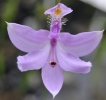|
|
|
|
 |
Email Address Recovery or Password Reset |
Use our Change Password page, and you can set a new password, or if you don't remember which email address you
registered with, the same page may be able to suggest it based on another you enter.
|
|
|
|
|
| |
Flasks of
Calopogon tuberosus 'MC5995' (pink) -spontaneous |
|
| |
|
|
| |
|
|
Click to Enlarge

Pod Parent Flower |
|
|
|
| |
For additional origin/habitat information supplied courtesy of
Charles and Margaret Baker, see further below, near the bottom of this page.
|
Temperatures we attempt to use in the lab & greenhouse:
| For Species: |
|
Spring, Summer, Autumn: days average 80°F, nights 61°F; best fit is Intermediate 83-60°F
(Source:
Baker's Web OSC) |
| For Species: |
|
Winter: days average 37°F, nights 25°F; best fit is Frigid 46-28°F
(Source:
Baker's Web OSC) |
|
About the name...
| Etymology of |
Calopogon |
|
From latinized Greek "kalos" beautiful; "pogon" beard. The lip has colorful hair-like appendices.
(Source:
Mayr & Schmucker 1998) |
| Etymology of |
tuberosus |
|
From Latin "tuberosus" having a tuber.
(Source:
Mayr & Schmucker 1998) |
| Pronunciation of |
Calopogon |
|
kal-oh-POE-gon
(Source:
Hawkes 1978) |
|
If you would like to direct someone to this web page, please copy and paste this URL into your email:
http://troymeyers.com/d?018293
| Flask Information |
| Availability: |
We have sold all of the flasks for this item. |
| You should: |
Consider getting individual plants or compots instead of a flask.
See if we have plants available in the greenhouse. |
| Yield Estimate: |
469 plants (based on flask surveys done 08/13/2017 through 08/09/2019)
|
| Plantlet Sizes: |
From many flasks 60 - 80 mm plants (based on flask surveys done 05/05/2018 through 07/10/2020)
From one most recently surveyed flask 60 - 80 mm (07/10/2020)
|
|
You might also want to:
|
View the seed assay for this item.
See if we have plants available in the greenhouse.
View items of the same species.
View items of the same genus.
|
| Ordering Information |
| You are not currently logged in. |
|
You must be a registered user and be logged in to reserve a flask or place a notification request. Please log in:
|
|
 |
Email Address Recovery or Password Reset |
Use our Change Password page, and you can set a new password, or if you don't remember which email address you
registered with, the same page may be able to suggest it based on another you enter.
|
|
|
|
|
|
|
|
| |
The origin/habitat information below is supplied courtesy of Charles and Margaret Baker
The following information is based on the name of the plant provided by the donor, and assumes that the name is correct. If the plant has been misidentified, then the following information may not be correct.
This text is copyrighted by the Bakers and may not be reproduced without permission.
ORIGIN/HABITAT: The United States. The area of distribution extends
eastward from east Texas, southern Arkansas, northward just west of the
Mississippi River to southern Canada and includes the entire region east
of the Mississippi from Florida to southeastern Canada, including
Newfoundland. In the north, plants are found in sunny marshes and bogs
where the small corm is buried rather shallowly in the moist, rich, acid
soil or moss. In the south, plants may be found in pinelands with the corm
buried rather deeply in sandy soil.
More about this information and the Bakers...
|
|
|
| |
|
|
|